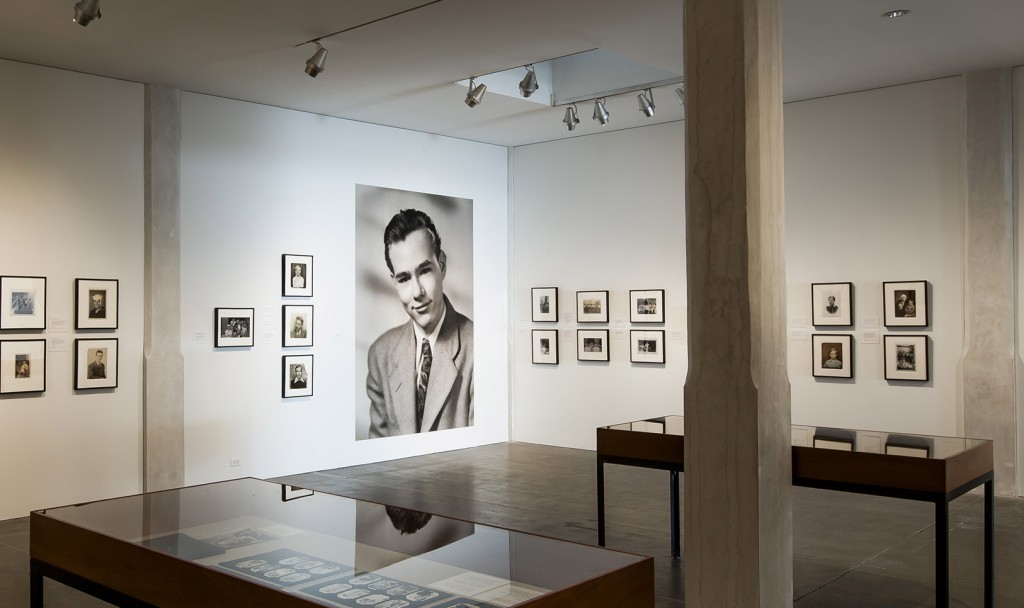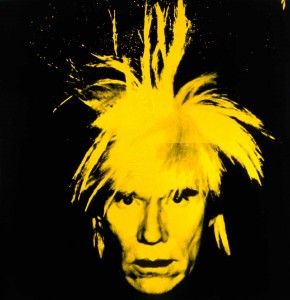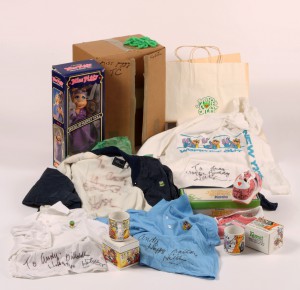The Elusive Andy and Why Elvis Won’t Leave: Behind the Scenes at the Remaking of The Warhol
“They always say time changes things, but you actually have to change them yourself.” — Andy Warhol
Pittsburgh’s Andy Warhol Museum has had an extreme makeover. In museum circles the operation is called a “rehang,” a term that is both inelegant and inaccurate. Much more was done at The Warhol than moving pictures around on the walls.
Inside the seven-story building, museum staff and contractors knocked out walls, re-shuffled entire galleries, and created new visitor areas. Added features range from the “ahh, it’s about time” variety—such as touch-screen stations where Warhol’s films and videos can be viewed on demand—to nice surprises like a good new film about Warhol, running nonstop on a theater screen.

The new 7th floor galleries trace Warhol’s upbringing and early career. His 1945 senior photo from Pittsburgh’s Schenley High School dominates this corner. (Gallery image from a series © Abby Warhola)
Also, the museum now takes you through Warhol’s life and the evolution of his art in more-or-less chronological order, trying to bring out story lines that weren’t always evident before.
For a visitor’s-eye look at the results of this remake, see our review. Meanwhile the thinking and work that went into it are worth a look as well. The job was done to coincide with the museum’s 20th anniversary this year, and though the milestone seemed to call for some sort of observance, rarely does an art institution utterly reinvent how it presents its subject. Thus one may ask: Why massively re-do a museum that was compelling to begin with?
A Vision for Conveying Many Visions
According to head curator Nicholas Chambers, the project came from “a new vision for the way the museum could work.” Chambers was hired two years ago, with donor funding, as The Warhol’s Milton Fine Curator of Art. This put him in the middle of planning the renovations, but he noted that the seeds of change were sown long before he arrived.
Since The Warhol opened in 1994, Chambers said, “People at this museum have done a tremendous amount of research” on every aspect of its operation. Along with ongoing studies of Andy Warhol and his art, various parties studied topics such as visitor responses to the museum and new trends in museum-ship generally. Upgrades and tweaks were made to The Warhol through the years, but larger ideas were taking shape.
As the 20-year mark loomed, said Chambers, “It was an opportunity to review the ideas and to build on all of that research. We wanted to bring new perspectives to bear on Warhol”—on the artist himself.

Warhol’s 1986 self-portrait combined rock-star flash with dark foreboding—notice the weary look. Andy died the next year, having produced an immense body of work. Much of it would go into the Warhol Museum. (Image © Andy Warhol Foundation)
And presenting Andy Warhol has always been a challenge. He was, for openers, a complex man personally. Here was someone who partied with A-list celebrities while living in a New York townhouse with his longtime closest friend, his mother. Someone who saw art and business as being deeply intertwined, yet is best known on that score for his seemingly brazen marketing stunts—like the time he placed an ad in the Village Voice, offering to endorse any products for money.
Likewise, Warhol’s body of work is more complex and diverse than many people realize. “He’s not just about Brillo boxes and Campbell’s soup cans,” said Chambers, referring to the works that often get Warhol stereotyped as little more than a Pop Art image-appropriator.
So the Warhol Museum took a fresh try at weaving together, for the public, the many strands of Warhol. Adding import to the task was the museum’s standing in the art world.
The Makings of a ‘Special’ Museum
As Pittsburgh’s civic boosters like to mention, The Warhol is the largest museum in the U.S. devoted to a single artist. In fact it is special for a more basic reason. It’s one of the few single-artist museums of substantial size anywhere, period.
Museums of this type are fairly rare, and many that exist are small (such as Mexico City’s Frida Kahlo Museum, in the house where Kahlo lived), because several factors must converge to produce a bigger one.
Obviously, the artist must be of wide interest. Others with prominent single-artist museums include Van Gogh, Picasso, Dali, and Georgia O’Keeffe (whose small museum in Santa Fe has been growing). Warhol easily met the “wide interest” test, and he continues to meet it: At the Warhol Museum’s 20-year gala event this year, one gallery had to be closed off because it was temporarily full of shipping crates. They held artworks just back from a major traveling exhibit that had toured cities in Asia, where Warhol’s art is very popular.
But sheer popularity isn’t enough. There must be parties that can muster the funding and the know-how to start a museum—which then must be filled with art. The latter can be tough, since artists often do the darnedest thing with their output. They sell it. For a sizable single-artist museum, plenty of good pieces must still be available after collectors and standard art museums have acquired what they want.
In Warhol’s case all of the requirements turned out to be met. When Andy Warhol died in 1987—shockingly, at the age of 58, from heart failure after a routine surgery—he died wealthy. His will directed that most of his estate be used to create the Andy Warhol Foundation for the Visual Arts, with the mission of making grants for “the advancement of the visual arts.” And though he didn’t specify starting a Warhol museum as part of that mission, a movement emerged to do so. The key players were his Foundation’s officers (who included John Warhola, the artist’s eldest brother); the Carnegie Institute of Pittsburgh, which would add the new museum to its “family” of museums; and New York’s Dia Art Foundation.
A former industrial building on the North Side was chosen as the site, and gathering the art wasn’t much of a problem. Warhol was incredibly prolific.
How Prolific?
Whereas it is common for artists to work in quantity, even making multiple versions of the same item—Edvard Munch, in his lifetime, made several versions of his masterpiece “The Scream”—Warhol mass-produced art. With the help of assistants he had churned out, for instance, stacks of portraits just of Marilyn Monroe. There were profusions of big flower paintings, sculptural pieces, drawings, prints of diverse subjects, and myriad more paintings. Warhol shot still photos constantly and made thousands of films and videos.
While many pieces were sold, many remained in inventory, eventually going into Warhol’s estate. His Foundation gave a big portion of those to the Warhol Museum: over 3,000 art pieces initially.

How now, purple cow? Though not as glamorous as Marilyn Monroe, Warhol’s 1966 “Cow” would become one of his best known mass-produced portraits. (Image © AWF)
Much more would be added in subsequent transfers and through gifts from Dia and others. Nor was that all. Coming aboard with the art were Warhol’s meticulous personal archives, artifacts from his business ventures, and belongings he had collected.
Far from scraping for material, The Warhol found itself the steward of an immense collection. Its holdings are so large, said Nicholas Chambers, that “only a small percentage” of the art can be shown at once. (The remaining pieces are sent out for temporary exhibits or kept in storage, awaiting rotation into use.) And thus it was that about two years ago, the museum’s current staff began to wrestle anew with a perennial issue: how to display things in a manner that is attractive to visitors while making sense of the multidimensional Mr. Warhol.
The Thinking Behind the Remake
“One overarching principle” came out of the discussions, Chambers said: the idea of arranging works in “a chronological display,” to show the progression of Warhol’s life and career. But that simple rubric could not be a total solution because Warhol branched out in so many directions. It is fair to say he expanded the very notion of what an artist is, and can do.
Along with creating art in practically every medium that existed, he created enterprises. He managed a rock band (the Velvet Underground) and produced concerts. He founded a magazine, Interview, that is now in its 45th year of publication. He made himself into a work of performance art, and even in that regard, he was multidimensional.
Most other artists have presented a consistent face to the public: Salvador Dali was flamboyant, for instance, ever striving to be as surreal in life as he was in his art. Warhol presented many faces. Sometimes he was the inscrutable sage behind dark sunglasses, doling out cryptic one-word answers in interviews, and sometimes he was the giddy social butterfly. He could be disarmingly eloquent; he hosted TV segments; he delivered punch lines with the deadpan timing of a stand-up comic; he sidelined as a fashion model.
Therefore, Chambers said, The Warhol’s staff followed another principle to guide the remake of the museum: “never trying to craft a singular narrative, a single monolithic Warhol story.” Instead the goal was to highlight different facets of Warhol’s “construction of himself”—not only in terms of his public image, but in “the ways he developed his artistic practice, his design persona.”
Finally, said Chambers, there was the subtle matter of finding a “voice” for the revamped museum: one that would speak in the arrangement of works and in the text panels to go on the walls beside them. The decision here was to speak “in a way that’s not didactic but inviting.” Visitors were to be “introduced” to Warhol’s world rather than given canned lectures on it.
A Short Trip for Elvis; the Long View for Film and Video
Every department of The Warhol had a hand in planning the remake, from the office of museum director Eric Shiner to people out across the ranks. Consultants and contractors were brought in, too. Work began in earnest in January of this year. Rick Armstrong, the museum’s communications manager, recalled marveling at some of the maneuvers that had to be executed.
There are artworks that “never travel out of the building,” Armstrong said. One is the gigantic horizontal silkscreen painting called “Elvis (Eleven Times),” which, at 36 feet across, is “just too big” to go on tour. For the remake this multi-Elvis had to move between floors, and he would not fit around corners in the stairwell. So they took him through the elevator shaft.
The new museum came into form gradually, with existing areas kept open until it was their turn to be worked on. And some new areas remained works in progress. Setting up the new Film and Video Gallery with its touch-screen viewing stations was a complicated affair. Software had to be tested and tuned; works that were made on 16mm film and videotape had to be loaded in as digital files, and so forth. At the Gallery’s launch, about 70 items could be searched and viewed—a prime selection, but only a fraction of the thousands now being added step by step from the rest of the vault.

To help document his times, Warhol filled hundreds of boxes with cultural artifacts and sealed them for opening later. This “Time Capsule” turned out to contain vintage Muppet merch.
To the chief art curator, that’s okay. Throughout the museum, Chambers said, “We have a template to work with in the future. The galleries are structured so that we can change certain aspects and add new displays,” all without losing the overall flow of the museum, he observed.
What Lies Ahead
Museum staff are looking forward to what comes next, Chambers said. He spoke with excitement about new temporary exhibits coming up, and more is on tap than new art for the walls.
The Warhol continues to stage events in the performing arts, such as cutting-edge music concerts. Its website also has news on other kinds of public programs, including one that has drawn growing interest. Among Andy Warhol’s personal effects were over 600 “Time Capsules” he’d assembled during his life. Each is a cardboard box filled with memorabilia and news clippings from its day. The Time Capsules are being opened one at a time, with the public invited to watch.
Finally, a much larger opening is in the works. As you may have seen in news reports, The Warhol plans to open a branch museum in New York City. This is a natural next step, since Warhol worked there, New York is big, and the present museum has more than enough art to show.
But it has been made clear that The Andy Warhol Museum’s home will remain in Warhol’s hometown, Pittsburgh. A new template is in place and the special-events mill is spinning. Your next visit can be now.
Mike Vargo is a freelance writer and editor based in Pittsburgh.
Share on Social Media
Follow Entertainment Central
Latest Stories
Sign up for the EC Newsletter







